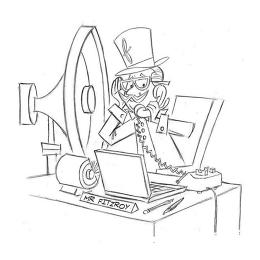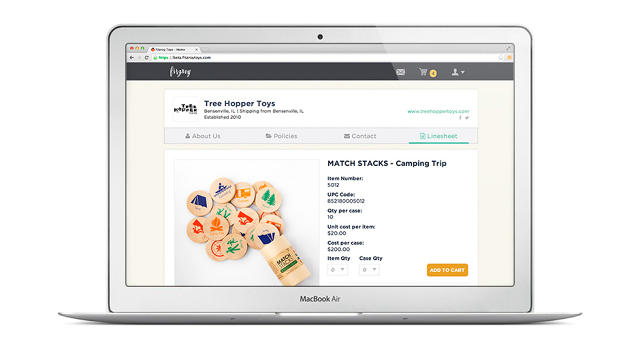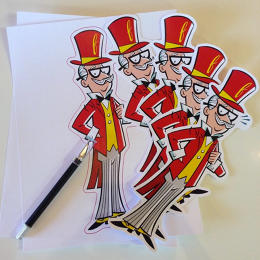How Fitzroy Toys Is Taking Indie Games Mainstream
The Kickstarter campaign is just the beginning.
The toy world has seen an explosion of innovative products in recent years thanks to fundraising tools such as Kickstarter, which allow far more independent makers than in the past to bring their creations to life. Yet despite the surge in novel toys, makers must still court retailers through the same staid methods available 50 years ago—going door-to-door with a sample and a cold sales pitch.
One might assume that getting fully funded represents the finish line for an indie company. But many makers say securing money is just the first in a series of hurdles on the path to putting an original toy into consumers’ hands. “Kickstarter and Indiegogo get you off the ground. But once you sell to your early adopters, you’re then left with boxes of your board game or stuffed animals, and what do you do then?” says Stefanie Botelho, founder and CEO of Fitzroy Toys, a new online marketplace connecting indie toymakers with curious sellers.

While the products have changed, key parts of the industry have not—including wholesaling, which still relies on a combination of old-fashioned paperwork and economies of scale to push toys into stores. The antiquated system puts an unexpected strain on startups, which curtails growth at the company level, and over time could stifle innovation industry-wide.
“It’s a very old-school mentality,” Botelho says. “Why so much paper? Why is it so hard? You should be able to do all of this online.”
Botelho likes to say Fitzroy Toys is her second toy company: as a fourth grader, she crafted finger puppets out of felt, glitter, and glue, and sold them to her classmates. After college, Botelho worked as an investment banking analyst and then in venture capital, investing in technology companies. When her boss announced she was pregnant, Botelho found herself in the toy aisle, shopping for baby gifts. “It was hard to find the kinds of toys that I wanted to give,” she says. “I love Frozen, but I wanted something that was a little more unique, a little more special. That’s the stuff that’s usually buried on Amazon and harder to find, because it’s from a small maker.”
In a coding class at Harvard Business School, Botelho built a toy recommendation engine as a class project and realized her idea could fill a niche. She began talking to the creators whose toys she was recommending. In each of their narratives, she heard a common theme: We built a great product, but how do we get noticed?

Those include Mary Beth Minton, who came up with the idea for her toy company, Zylie & Friends, in the late 90s. A nonprofit director and mother of three, Minton wanted to give her children a play experience she felt was missing: a stuffed animal that could be dressed up like a doll, which would entertain children with stories rather than screen time.
In 2009, Minton created a teddy bear prototype with the help of YouTube videos and a sewing machine, and shopped it around to toy executives and fellow Wharton School alums. Their reaction was not encouraging. “They basically told her, ‘You’re crazy for trying to start a teddy bear company in this industry,’” recalls Matt McCarty, Minton’s son, who by then had graduated from Vanderbilt. He believed in the idea, and in 2010 the mother-child duo self-funded Zylie & Friends’ launch.
At first, it seemed like Zylie had the naysayers beat. Their plush bears and adventure books won several prestigious toy industry awards, landed a coveted spot on The Today Show and won a rush of consumer buzz—but despite the hype, they still needed a business plan. Along with selling to customers through their website, they wanted Zylie on toy store shelves. There, they hit a brick wall.
Carly Gloge, co-founder and CEO of Ubooly, has a similar story. After their toy—an interactive plush animal powered by a smartphone or tablet—was successfully funded on Kickstarter in 2012, Gloge and her team tried to reach new customers via banner ads online, but they resulted in few sales. “You definitely get that hangover after Kickstarter, trying to figure out how to get some new eyeballs,” she says. “It seems easy: All of these people are going to give you money to go make your product—but it’s tougher than that.”
Wholesale, Gloge says, “is a huge burden.” Selling 100 units to a retail store requires inventory management and packing and shipping capacity well beyond what it takes to send one or two toys to a single consumer. Once indie makers exhaust their local retail options, they have to hire either an internal sales rep or a costly middle man to grow the business. Then comes the onslaught of faxes, phone calls and carbon paper forms. “Even small toy companies have to have two to three people just handling taking orders and formatting them,” Gloge says—an additional expense she and her company struggled with.

Via Fitzroy, which launched in beta in December, small makers can secure wider distribution without having to hire expensive sales representatives, and specialty retailers can more easily locate appealing, quirky products they might not find through traditional routes. The marketplace lets retailers browse toys by brand, category (books, dolls, even environmentally friendly toys) or the target age of the child. But it’s more than an online catalogue—it’s also a platform that allows store owners to easily purchase and repurchase toys, and gives toymakers a central portal to communicate with potential sellers and manage dozens of retail accounts in one place. Small toy teams and specialty stores that might not have access to industry trade shows can find one another, free of charge (like Etsy, Fitzroy charges toymakers a transaction fee).
Zylie & Friends eventually found its way to Fitzroy as part of the beta launch, where the brand has thrived. “On the discovery side, I find it very valuable,” says McCarty, who has used Fitzroy to broaden Zylie & Friends’ reach. “It changes the dynamic. We’re not knocking on the door and then finding the vendor is not a good fit—now a retailer can go online and find us.”
For JoyLabz, the company behind circuit-board music kit MaKey MaKey, the ability to connect with like-minded retailers is a big draw. MaKey MaKey—famous for its promo video, in which a home inventor turns bananas and a flight of stairs into makeshift keyboards—clinched 2,000% of its Kickstarter goal in 2012. Although wildly popular online, the kits didn’t debut on store shelves until last year, when the Museum of Modern Art acquired MaKey MaKey for its permanent collection. Even with a wave of buzz, it was tough for the company to reach retailers who would take the time to understand a multi-hyphenate product like theirs.

“Fitzroy helps us straddle the line between online ecommerce and traditional toy sales,” says JoyLabz vice president Todd Eddie. “In the traditional toy world, we don’t have sales reps to explain to every individual store how our product works. Fitzroy is effectively our sales rep, but in an online presence.”
Eddie is also banking on the platform to streamline the order-taking process—a boon for the company’s four-person team. “The nice thing about working with Fitzroy is they handle a lot of things that we would have to hire additional staff to do,” he says. “With Fitzroy, all we have to do is worry about fulfillment.”
Retailers benefit, too. Tara Riceberg, owner of Los Angeles toy shop Tweak: The Original Giftery, typically scours toy conventions and the web for unconventional products that resonate with her values. “Everything I source has to make you smarter or make you smile,” she says. “I am constantly buying; I want my products to continuously turn over and be visually stimulating.”
Despite the hardships, there are boons to being an indie maker in today’s toy market. Crowdfunding has ushered in a Wild West-like era in which the rules are rapidly changing, and anyone with a strong product and a little marketing savvy can strike customer-attention gold. “It’s an exciting time for indie toy companies. There’s an opportunity for them to offer things the big toy companies aren’t into,” Gloge says. And that, McCarty adds, makes it easier to compete. “There are fewer gatekeepers,” he says. “It’s an interesting industry to navigate right now.”
Plus, the definition of a toy is expanding. Novelty toys and games are appearing in more types of stores, from Paper Source and Urban Outfitters to nurseries and museum gift shops. “Toys are becoming more a part of lifestyle shopping,” Botelho says. “It’s not just blocks or just a stuffed animal—it’s going to be something more.” The more variety kids and parents find on shelves, the higher chances rise that every child will find something stimulating, inspiring, and fun.
Seven months into running Fitzroy, Botelho is already thinking about the future: she envisions Fitzroy Toys as the go-to marketplace for the next generation of toy creators and retailers. “For us, what’s important is that we build something both sides will use,” she says. “I think there’s a huge opportunity to become a standard within the industry.”
Fast Company , Read Full Story
(84)


